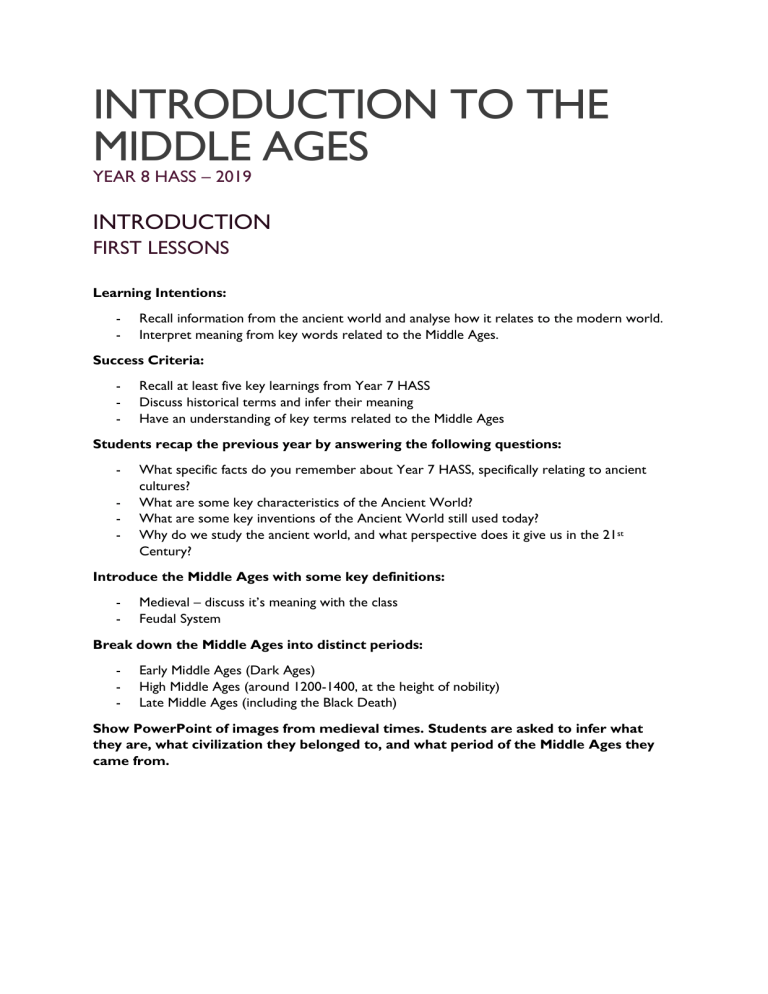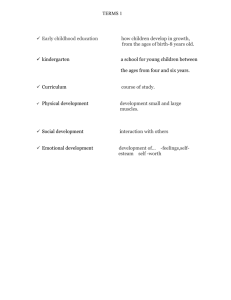
INTRODUCTION TO THE
MIDDLE AGES
YEAR 8 HASS – 2019
INTRODUCTION
FIRST LESSONS
Learning Intentions:
Recall information from the ancient world and analyse how it relates to the modern world.
Interpret meaning from key words related to the Middle Ages.
Success Criteria:
Recall at least five key learnings from Year 7 HASS
Discuss historical terms and infer their meaning
Have an understanding of key terms related to the Middle Ages
Students recap the previous year by answering the following questions:
What specific facts do you remember about Year 7 HASS, specifically relating to ancient cultures?
What are some key characteristics of the Ancient World?
What are some key inventions of the Ancient World still used today?
Why do we study the ancient world, and what perspective does it give us in the 21 st
Century?
Introduce the Middle Ages with some key definitions:
Medieval – discuss it’s meaning with the class
Feudal System
Break down the Middle Ages into distinct periods:
Early Middle Ages (Dark Ages)
High Middle Ages (around 1200-1400, at the height of nobility)
Late Middle Ages (including the Black Death)
Show PowerPoint of images from medieval times. Students are asked to infer what they are, what civilization they belonged to, and what period of the Middle Ages they came from.
RECAPPING SOURCES
Learning Intentions:
Distinguish between a primary and secondary source
Success Criteria:
Correctly understand the difference between Primary and Secondary sources.
Complete an analysis of source material.
Students are asked to define a Primary and Secondary source.
This can be done by some simple activities, such as talking to a partner about themselves (primary), and then talking to their partner about their partner (secondary).
Read Pages 6-7 of History Alive 8 – Life in the Middle Ages
Ask students to reflect on what life was like in the Middle Ages – could they see themselves living there?
Hand out worksheet (photocopied from HA8 Student Workbook) – Analysing a Visual
Source.
Students to work through this – analysing the image and making inferences based on their interpretation of it.
TIMELINE ACTIVITY
Learning Intentions:
We are learning how to create a timeline and identify significant historical events
Success Criteria:
Create a timeline spanning 100 years identifying significant historical events
Format the timeline using correct terminology and scale
Present a cohesive timeline, with attention to overall presentation.
Break students into 9 groups – each group has a century of the Middle Ages.
Students develop a timeline of their specific century, outlining key events across multiple civilizations.
Students use devices to compile material, then print and use a coloured A3 page as backing. Can be displayed in order on classroom walls. (Students may need extended time to log into devices for first time).
Assess finished timelines based on Success Criteria and ACARA outcomes.

